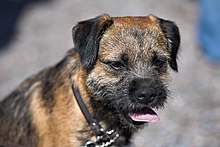| This article needs additional citations for verification. Please help improve this article by adding citations to reliable sources. Unsourced material may be challenged and removed. Find sources: "Border Terrier" – news · newspapers · books · scholar · JSTOR (April 2021) (Learn how and when to remove this message) |
| Border Terrier | |||||||||||||||||||
|---|---|---|---|---|---|---|---|---|---|---|---|---|---|---|---|---|---|---|---|
 Male Border Terrier Male Border Terrier | |||||||||||||||||||
| Origin | United Kingdom | ||||||||||||||||||
| |||||||||||||||||||
| |||||||||||||||||||
| Dog (domestic dog) | |||||||||||||||||||
The Border Terrier is a British breed of small, rough-coated terrier. It originates from the area of the Anglo-Scottish border, and shares ancestry with the Dandie Dinmont Terrier and the Bedlington Terrier from the same area. The dogs were traditionally used in fox-hunting, and worked with the Border Hunt in Northumberland.
The breed was officially recognised by The Kennel Club in Great Britain in 1920, and by the American Kennel Club in 1930.
History
Originally the Border Terrier was referred to as the Coquetdale Terrier or Redesdale Terrier from the area in which it evolved, but by the late 1800s it was generally known as the Border Terrier, probably because of its long history with the Border Hunt in Northumberland.
It shares its ancestry with that of the Bedlington Terrier and the Dandie Dinmont Terrier. It was recognised as a breed by the Kennel Club in 1920, the same year The Border Terrier Club was formed. Their original purpose was to bolt foxes which had gone to ground. They were also used to kill rodents, but they have been used to hunt otters and badgers too.
The first Kennel Club Border Terrier ever registered was The Moss Trooper, a dog sired by Jacob Robson's Chip in 1912 and registered in the Kennel Club's Any Other Variety listing in 1913. The Border Terrier was rejected for formal Kennel Club recognition in 1914, but won its slot in 1920, with the first standard being written by Jacob Robson and John Dodd. Jasper Dodd was made first President of the club.
In 2006, the Border Terrier ranked 81st in number of registrations by the AKC, while it ranked tenth in the United Kingdom.
In 2008, the Border Terrier ranked eighth in number of registrations by the UK Kennel Club.
Characteristics

The Border Terrier was bred to have long enough legs to keep up with the horses and other foxhounds, which travelled with them, and small enough bodies to crawl in the burrows of foxes and chase them out so the hunters had a blank shot. The foxhounds that travelled with them were not small enough to do the Border Terrier's job.
Border Terriers have a broad skull and moderately short muzzle, and strong teeth. The V-shaped ears are on the sides of the head and fall towards the cheeks. Common coat colours are grizzle-and-tan, blue-and-tan, red, or wheaten. Whiskers are few and short. The tail is moderately short, thick at the base and tapering.
Narrow-bodied and well-proportioned, males stand 13 to 16 in (33 to 41 cm) at the shoulder, and weigh 13 to 15.5 lb (5.9 to 7.0 kg); females 11 to 14 in (28 to 36 cm) and 11.5 to 14 pounds (5.2 to 6.4 kg).
The Border Terrier has a double coat consisting of a short, dense, soft undercoat and harsh, wiry weather- and dirt-resistant, close-lying outer coat with no curl or wave.
Health



Canine epileptoid cramping syndrome is a condition that is recognised to occur in the Border Terrier.
A 2024 UK study found a life expectancy of 14.2 years for the breed compared to an average of 12.7 for purebreeds and 12 for crossbreeds.
A UK study found a predisposition to gall bladder disease in the Border Terrier. The breed was found to be 86.48 times more likely to acquire gall bladder mucocele and 28.7 times more likely to acquire other forms of gall bladder disease compared to other dogs. The study also found a predisposition to neutrophilic cholangitis, with the breed being 12.07 times more likely to acquire it.
See also
References
- ^ Border Terrier. The Kennel Club. Accessed May 2021.
- "History of the Border Terrier". Archived from the original on 23 July 2014. Retrieved 23 July 2014.
- "AKC Dog Registration Statistics". Akc.org. 2 February 2009. Archived from the original on 16 July 2007. Retrieved 20 February 2009.
- "2006 Top 20 Breed Registrations". The Kennel Club. 23 January 2007. Archived from the original on 15 April 2009. Retrieved 20 February 2009.
- "RUNNING WITH THE HOUNDS". 30 June 2021.
- "RUNNING WITH THE HOUNDS". 29 June 2021.
- ^ "American Kennel Club - Border Terrier". Akc.org. Archived from the original on 19 February 2009. Retrieved 20 February 2009.
- Marilyn A Reed - Small World Web Design. "Canine Epileptoid Cramping Syndrome". Borderterrier-cecs.com. Archived from the original on 28 February 2009. Retrieved 20 February 2009.
- "Canine Epileptoid Cramping Syndrome". Genetic Welfare Problems of Companion Animals. ufaw.org.uk: Universities Federation for Animal Welfare. Archived from the original on 8 March 2015. Retrieved 10 February 2015.
- McMillan, Kirsten M.; Bielby, Jon; Williams, Carys L.; Upjohn, Melissa M.; Casey, Rachel A.; Christley, Robert M. (1 February 2024). "Longevity of companion dog breeds: those at risk from early death". Scientific Reports. 14 (1). Springer Science and Business Media LLC. doi:10.1038/s41598-023-50458-w. ISSN 2045-2322. PMC 10834484.
- Bandara, Y.; Bayton, W. A.; Williams, T. L.; Scase, T.; Bexfield, N. H. (2021). "Histopathological frequency of canine hepatobiliary disease in the United Kingdom". Journal of Small Animal Practice. 62 (9): 730–736. doi:10.1111/jsap.13354. ISSN 0022-4510.
| Dogs originating in the United Kingdom | |||||||
|---|---|---|---|---|---|---|---|
| Hounds | |||||||
| Gun dogs | |||||||
| Terriers |
| ||||||
| Herding dogs | |||||||
| Other | |||||||
| Extinct |
| ||||||
| |||||||
| Scottish domestic animal breeds | |
|---|---|
| |
| Cattle | |
| Dogs | |
| Horses | |
| Pigs | |
| Poultry | |
| Sheep | |